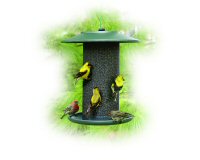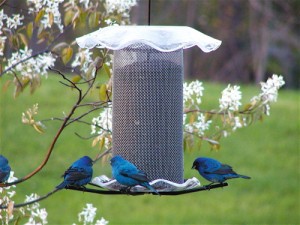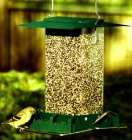-
A Thistle Feeder and Finch Feeding Tips
Many species of birds will visit your feeders, but unlike most other birds, the Goldfinches’ diet consists mainly of seed. Most finches will feed their chicks insects, while American Goldfinch chicks get the same thistle seed their parents eat. When parents return to feed chicks, it is digested thistle (or nyjer seed), enough for the whole brood. Young are fed about twice an hour, this is why Goldfinches perched at your feeder will eat seed after seed. It’s a great opportunity to view them in detail.
One key to keeping Goldfinches around is eliminating the need to compete. They are known to fly away and give up when other species crowd a thistle feeder. Inexpensive thistle sacks are a good way to offer several separate feeders, thus eliminating the competition for food.
Another important measure is to keep thistle seed fresh. Many times the seed at the bottom of the thistle feeder gets packed down and draws moisture, birds won’t eat spoiled seed. It’s important to completely dump old seed when refilling the feeder.
To enjoy Goldfinches’ vibrant yellow color in warmer months, it’s advised to keep a thistle feeder out year-round, filled with fresh seed at all times.
-
Thistle Feeders…Not Just for Finches!
You can attract a great variety of songbirds with thistle feeders. Thistle, also called Nyjer seed resembles grains of wild rice, and is coveted by American Goldfinches for its high fat and protein content. Other songbirds who will feast at your thistle feeders include: House and Purple Finches, Towhees, Pine Siskins, Juncos and vibrant Indigo Buntings, as pictured at left. Another great benefit of feeding thistle seed is that it has been heated to prevent germination, so sprouting weeds and grass below your feeder is not even an issue!
Mixing Nyjer with finely chopped sunflower hearts reduces mess in the yard and patio. Also, Pine Siskins and others prefer this to straight thistle seed. Commercial Finch mixes are readily available as well for use in thistle feeders.
-
squirrel proof bird feeder
When it comes to bird feeders and squirrels, most folks will say good luck! But with a little attention to feeder placement and the use of squirrel baffles or a squirrel proof bird feeder, you can minimize pesky squirrels at your feeders and enjoy the birds a whole lot more.
Protect your bird feeders in the yard from squirrels with these easy tips:
First, feeders need to be at least eight feet from any horizontal launching point.
Next, the bottom of the bird feeder should be at least four and one half feet off the ground. When using a pole or post, a squirrel baffle must be placed right below the feeder to ensure non-entry for squirrels.
For hanging feeders, make sure the baffle is at least one-third larger in circumference than the feeder.
If you are feeding on your deck or patio, and don’t have adequate room for a baffle, then a squirrel proof bird feeder should be used. Many models on the market today have effective and ingenious ways of combating squirrels.


 You can attract a great variety of songbirds with thistle feeders. Thistle, also called Nyjer seed resembles grains of wild rice, and is coveted by American Goldfinches for its high fat and protein content. Other songbirds who will feast at your
You can attract a great variety of songbirds with thistle feeders. Thistle, also called Nyjer seed resembles grains of wild rice, and is coveted by American Goldfinches for its high fat and protein content. Other songbirds who will feast at your  When it comes to bird feeders and squirrels, most folks will say good luck! But with a little attention to feeder placement and the use of squirrel baffles or a
When it comes to bird feeders and squirrels, most folks will say good luck! But with a little attention to feeder placement and the use of squirrel baffles or a